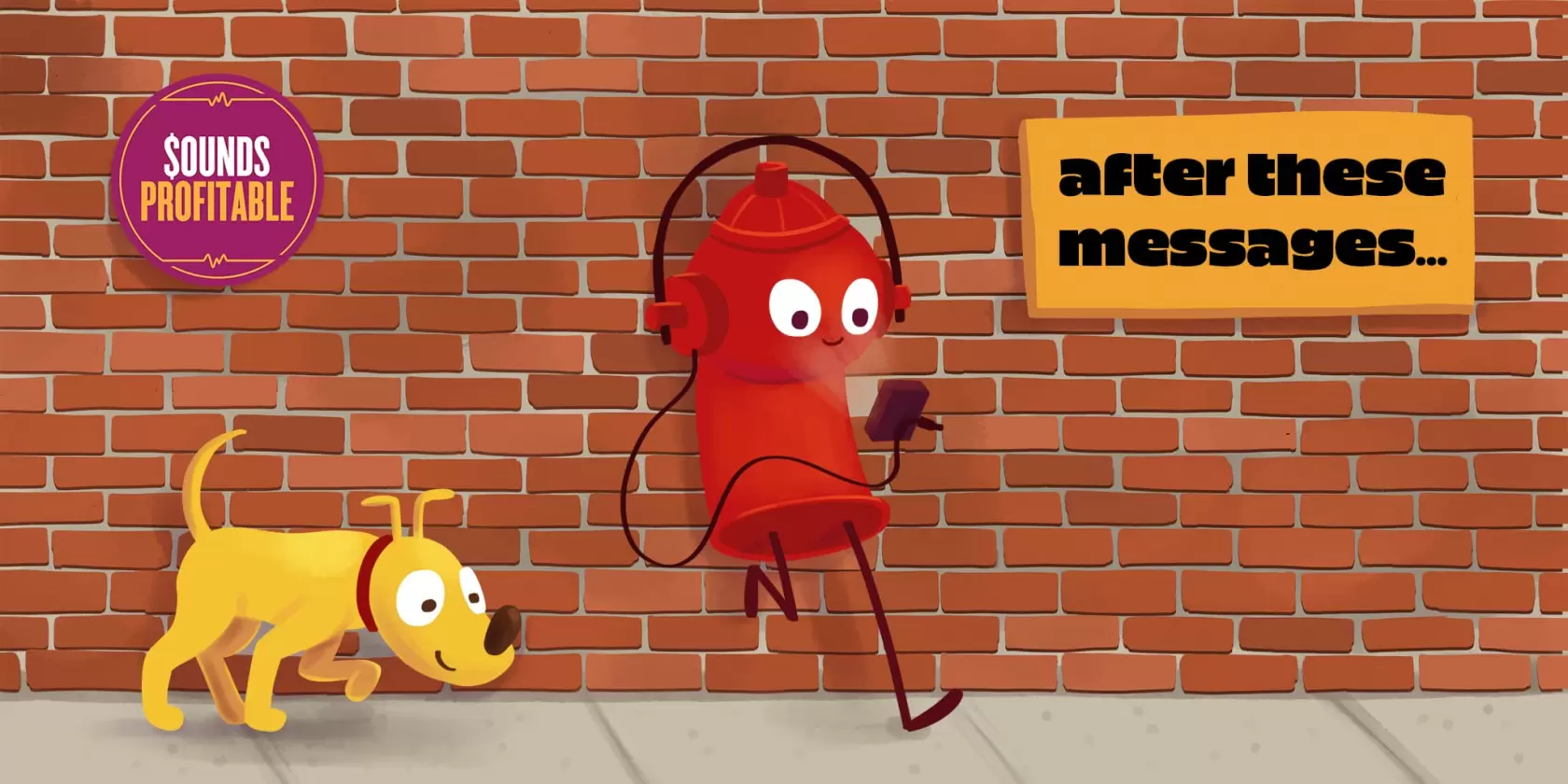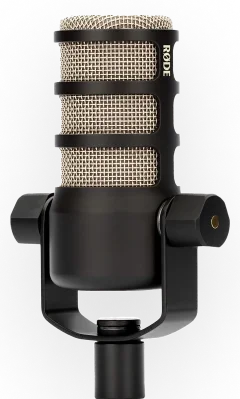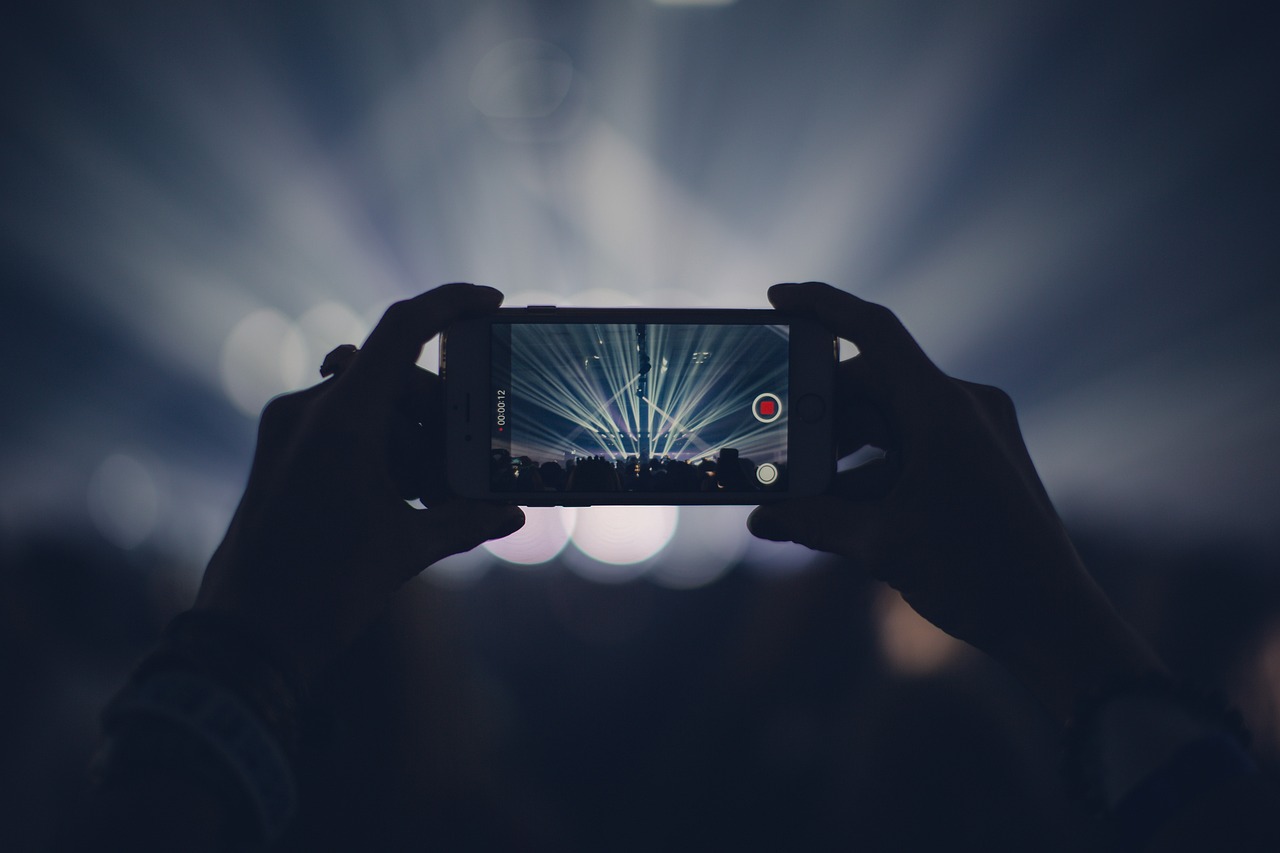Did you know that on top of monthly consulting, Sounds Profitable provides sponsors and all of their employees access to a private Slack channel and a monthly webinar (happening tomorrow!)? Hit reply to find out more!
At Podcast Movement in Dallas this year, Sounds Profitable released our second research project, After These Messages (which I will call ATM for short, though it does not dispense cash automatically.) We studied the differences among three types of podcast advertising execution: a live, “ad-libbed” host read of an ad, a scripted ad read by the host, and the same scripted ad read by a professional announcer who fit the style and mood of the podcast we selected.
I’ve worked on over a hundred advertising effectiveness studies in one form or another, and I can tell you that there is no “perfect” study. But for this project, we wanted to see just how pristine a research design we could practically engineer to get to the heart of the differential appeal and lift of these three popular ad executions. We stayed away from things like “baked-in vs. DAI” because the listener doesn’t make these distinctions. Any form of advertising can be delivered baked in OR with DAI, directly sold or sold programmatically. The real distinctions are in how the ad is executed, not delivered. I mean, thinking host-read ads can’t be delivered via DAI is a failure of the imagination, right?
To make the results meaningful, we knew that we needed to execute all three ads as well as we could, and that they had to be housed in content that would fit and showcase the ad as much as possible. So we chose a very popular show (The Jordan Harbinger Show) and an extremely mass-appeal episode (Jordan’s interview with Matthew McConaughey.) We then chose a brand that we knew Jordan’s audience would know, but one that wasn’t a ubiquitous insurance company: Athletic Greens. Finally, Jordan recorded both a “live read” version of a spot, and a scripted spot. We also engaged Ashley Hamer Pritchard (among other things, the former co-host of Curiosity Daily and a fantastic talent) to read the same scripted ad as Jordan
We played that content for 1049 weekly podcast listeners, sampled from an online panel and weighted to the latest Infinite Dial statistics from Edison Research (who fielded this study for us), Wondery, and ART19. In addition to the show segment, one of the three ad treatments was also included (so, about 350 podcast listeners heard each one). In this sample we also had 300 persons who had ever listened to Jordan’s show, which gave us a wonderfully robust subgroup with which to compare the total results.
It Turns Out, Podcast Advertising Works
And those results, my friends, were remarkable. I encourage you to download the study and watch the entire presentation here, but I’ve summarized the most meaningful stats on this slide:
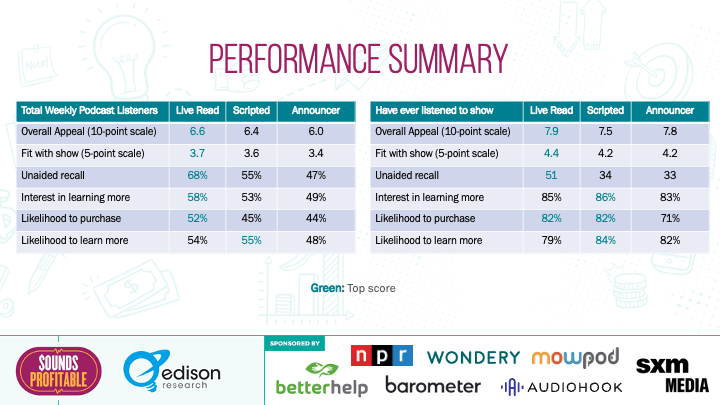
Let’s talk about the left side of this chart first. With the total sample, the “live”, ad-libbed read by Jordan was clearly the best, with 68% of the sample hearing that ad able to recall the brand name without aid (they simply wrote in “Athletic Greens” when asked if they recalled any brands mentioned in the content they had just heard.) That’s an extremely good number, especially for a brand that (while a major podcast advertiser) is not available in retail stores.
That said, the announcer read by Ashley did really well, with nearly half of the sample able to recall the brand without aid. It is certainly apparent that the live, host-read ad was the best driver of likelihood to purchase, interest in learning more, and (of course) fit with the show. But in every measure, the scripted read from an announcer performed wonderfully. I can assure you that if I had shown the announcer read scores to a client in a brand lift study, they would have been delighted.
Part of the reason for this was (hold on to your hats here) that Ashely did a good read. It wasn’t a crappy radio spot. It was warm and intelligent and 100% within the ethos of Jordan’s show. It didn’t violate the listeners’ earballs. But there was something else, and the key to that can be found on the right side of the chart above.
The right column lists the scores among those respondents who indicated they had ever listened to Jordan’s show, and as you might have guessed (and hoped!) the scores were significantly higher in most cases. The average likelihood to purchase the brand with Jordan’s listeners was 82%, which in technical terms is ginormous. Similarly, the “fit” with the show and the overall appeal of the ad were much higher and probably scored better than the content on some other (non-Jordan) podcasts!
A Counter-Intuitive Finding
Still, there were two very intriguing findings within these data. First, though there was a clear pecking order with the three reads among the total sample, with Jordan’s listeners, the three reads were essentially tied in many categories. Indeed, the overall appeal of the announcer-read spot was statistically no different to Jordan’s live read.
Second, the unaided recall stats for the brand were actually lower than they were with the total sample, which initially surprised us. How could an ad that performed so much better in every other way have significantly lower recall with actual show listeners than with people who’d never heard Jordan?
The answer was revealed in two key stats:
- Jordan’s listeners were more than twice as likely to have already been familiar with the brand (62%, vs 26% for those who have never listened to the show.)
- Jordan’s listeners were ten times more likely to have purchased the product (41% vs. 4%).
And those two stats suggest a tantalizing theory for how all of this works. Athletic Greens has been an advertiser on Jordan’s show for a while, so naturally his audience is more familiar with the brand, and (reassuringly for our entire industry) they’ve purchased it! Which means that in the context of this study, the sample of Jordan’s listeners hadn’t just heard of the brand, they were familiar with it. It was, in fact, a part of the show.
So when we asked his listeners if they heard a brand advertised in the content, for at least some percentage the answer was no because it didn’t necessarily register as an ad. But in subsequent questions from aided recall to appeal to likelihood to purchase, the scores showed that this audience was in fact incredibly receptive of the advertising and positive towards the brand.
Reassuringly, this stuff works.
The Known-New Contract
So, if we think about the receptivity of an audience to a host-read ad, and one that they have heard for a while, the performance of the announcer-read ad with Jordan’s fans actually makes a ton of sense to me. In the year 14 BP (before podcasting), I spent a couple of years teaching Rhetoric and Composition to incoming first-year students at Penn State. One of the foundational principles of rhetoric is something called the Known-New Contract. If you want to introduce something new to the recipient of a message, it will be more effective if that message is clothed in something familiar first.
Intuitively, this should make sense to you. In advertising, it explains the power of the celebrity endorsement, or even the voice read by a famous actor. Donald Sutherland sold a lot more Volvos than I ever could because his voice was familiar, and served as a warm welcome to a brand you might not have considered. Even if I were to crash in a Volvo, I would do so secure in the knowledge that I would be cradled safely in the folds of that gravely baritone, and hopefully side airbags.
The same thing, I submit, happens with host-read ads, which is apparent when we look at the scores with people who weren’t Jordan listeners. The newcomer to Athletic Greens is given a warm entry to the brand by a familiar voice–the host who had just delivered compelling content–which makes them more receptive to the new, which is the brand. This is why host-read ads are, in the words of my friend Marshall Williams, “beachfront property.” The host read escorts the brand safely past the initial barriers many of us put up to advertising, especially today in an era where we spend so much money on ad-free subscription content.
So why did the announcer-read ads perform equally well with Jordan’s listeners? It’s the same contract, in reverse: for many of them, the “known” quantity here was the brand. It’s been there all along, supporting the content that his fans know and love. And that, in turn, made Jordan’s audience more receptive to the “new,” which in this case was Ashley’s voice.
Wild, huh?
What It All Means
Now, this is a theory, of course. It’s better than an educated guess, however (I’ve seen a lot of these studies.) But what all of this suggests is that if you frame the podcast advertising “choice” as host-read vs. announcer read, you might be making a false choice, because they work differently, and each may be more effective than the other depending on the context.
The host-read ad may be the best way to introduce a brand “cold” to an audience, with the host “vouching” for the brand, serving as its ambassador (especially for live reads), and generally providing the brand a warm welcome. It may not really even be that important for the brand to cram all of its messaging into these, because that’s too many steps at once. The host provides a red carpet for the brand and tells their audience that this brand is OK, supports this show, and is worthy of your attention.
When that warm introduction is made, perhaps later in a campaign, it may be that using an announcer-read spot becomes a more efficient and cost-effective way to transmit the specific features and benefits of a brand. Let’s face it, there are many live host reads that eventually fall flat as the host tires of waxing poetically about insurance or motor oil. But this is when the announcer read can shine. That warm, contextually and tonally congruent spot will never tire of consistently delivering the messaging crucial to the brand and their metrics for success.
There is a lot more to digest in this wonderful study. So much, in fact, that we will be putting out a Part Two very soon! But I hope I’ve put the question to rest of which works better: host-read, or announcer-read spots. The answer, of course, is yes.
New Sponsors
Sounds Profitable exists thanks to the continued support of our amazing sponsors. Monthly consulting, free tickets to our quarterly events, sponsor-only webinars, and access to our 500+ person Slack channel are all benefits of sponsoring Sounds Profitable.
- The Axis – the podcast agency for aesthetic medicine.
- Transistor is modern podcast hosting and analytics
Want to learn more about sponsorship? Hit reply or send us an email!
Market Insights with Magellan AI
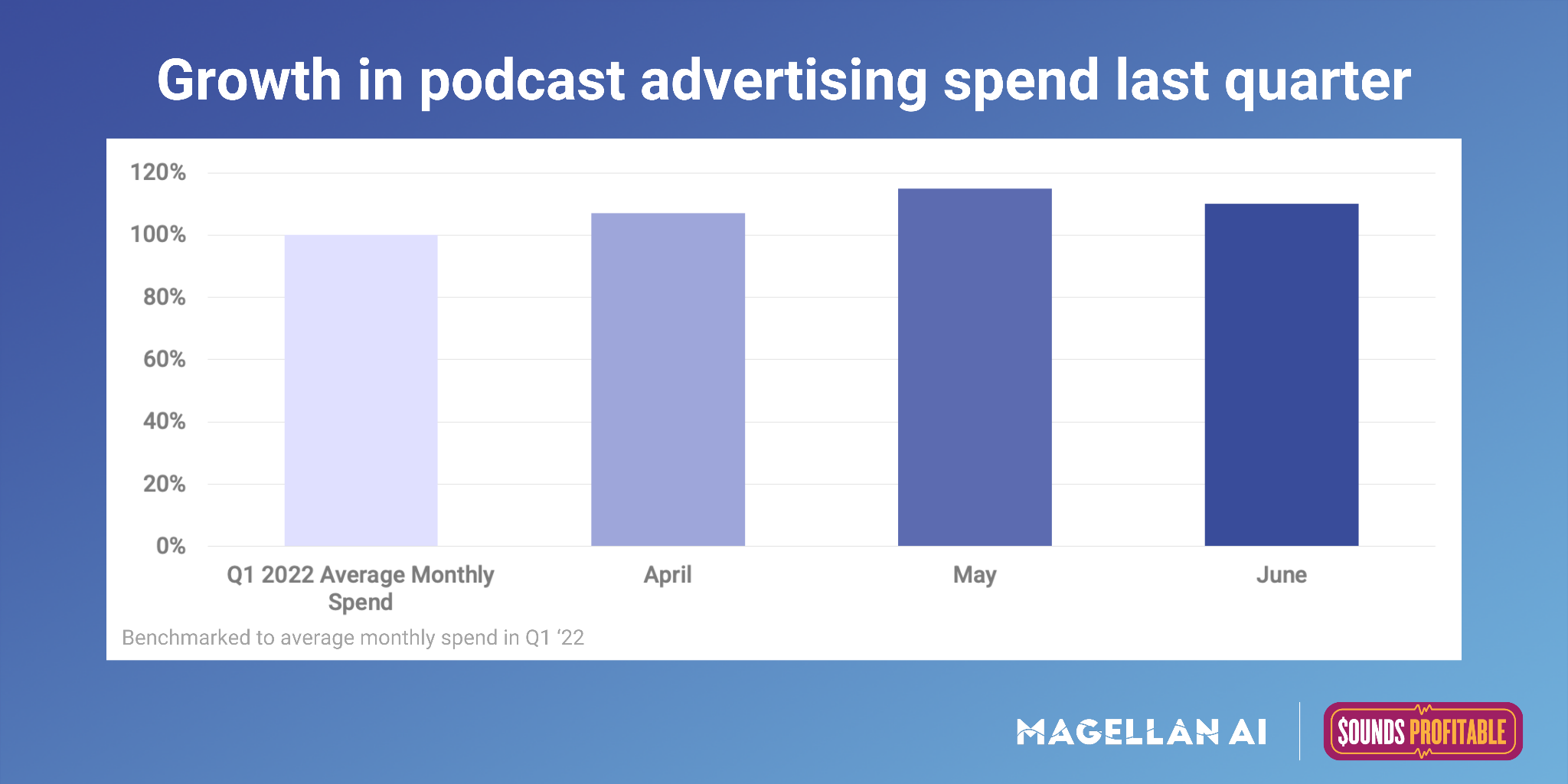
Continuing our series on market-wide trends in Q2, this week dug into how much overall advertiser spend has grown in Q2’22. To accomplish this we benchmarked spend in April, May, and June to average spend in Q1’22.
We found that in Q2’22 average spend increased by 11% from Q1’22, an increase that was roughly in line with the increase we saw between Q4’21 and Q1’22. Partly driving the increase, the total spend of the top 10 advertisers in Q2’22 was up 13% since Q1’22. Additionally the ad loads we detected on episodes published in Q2’22 were up 0.25% since Q1’22. For the most part we are seeing a greater increase in spend coming from brand awareness advertisers, but direct response spend is up as well. Using trends of prior quarters as a baseline, we would expect to see spend continuing to grow til Q4’22.
Interested in more insights like this? Download the Q2’22 Podcast Advertising Benchmark Report for a full analysis
Anatomy of an Ad with ThoughtLeaders

Sponsoring brand: Ka’chava
Where we caught the ad: Afford Anything
Where else has this brand appeared? Phil in the Blanks, Sense of Soul Podcast, The Last Laugh, Everything Everywhere Daily
Why it works: Personal anecdotes go a long way with ad-reads and the host of Afford Anything did it really well. The host mentioned that she landed late the night before and wanted something healthy – Ka’chava came in clutch. She then mentioned the benefits and highlighted why she loves using this product/service. Honestly, she persuaded me to give Ka’chava a try!

